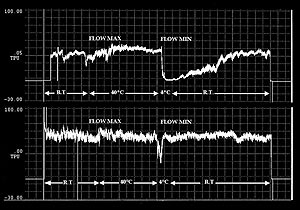Role of blood flow in glaucomatous progression requires further study
Vasospastic patients appear to be more sensitive to changes in IOP, research indicates.
|
|
A longer-term prospective study on the role of blood flow and the effect of treating blood flow in glaucoma is needed to gain a better understanding of the disease, according to a presenter here.
Speaking at the annual Sally Letson Symposium, Mark R. Lesk, MSc, MD, a researcher and ophthalmologist, described research that has been conducted on blood flow, various tools that measure blood flow and the relationship between IOP, blood pressure and blood flow.
He said factors such as hemorrhages, localized restriction of retinal arteries and peripapillary atrophy point to a vascular role in glaucoma.
Previous research
In population-based glaucoma surveys throughout the world, an increased risk of glaucoma in patients with lower ocular perfusion pressure has been found, Dr. Lesk said.
“In the Baltimore eye study, patients with lower blood pressure and lower perfusion pressure had an increased prevalence of glaucoma,” he said. “This was also found in Italy, Holland and Barbados.”
Research has indicated that patients with progressive glaucoma have greater nocturnal blood pressure dips than patients with stable glaucoma.
|
|
| |
| In patients with low-tension glaucoma, flame-shaped hemorrhages (left) on the optic nerve head and peripapillary retinal atrophy are more frequently seen than in patients with high-tension glaucoma. Localized constrictions of retinal arteries (right) in the vicinity of the optic nerve can occur in glaucoma and also in anterior ischemic optic neuropathy. Image: Fuizzotto D | ||
“You may have low blood pressure occurring at the same time as increased intraocular pressure at night, which may be quite nefarious,” Dr. Lesk said.
One study of nonglaucomatous patients with hypertension compared the effect of treatment of hypertension in smokers vs. nonsmokers.
“When the hypertension was treated medically in the nonsmokers, there was an improvement in neuroretinal rim blood flow, which we assume is related to the vasodilation effect of the drugs and the disappearance of the vasospasm which is associated with hypertension,” he said. “However, in smokers, who have a lot of atherosclerosis, their neuroretinal rim blood flow actually went down when their blood pressure was regulated.”
Vascular phenomena may help explain the findings from the Collaborative Normal-Tension Glaucoma Study in which women and those suffering from migraines and disc hemorrhages had higher rates of progression to glaucoma, Dr. Lesk said.
It has been postulated that postmenopausal women experienced higher rates of progression to glaucoma because of a loss of estrogen, which acts as a cerebral vasodilator.
There are many techniques to measure blood flow, including laser Doppler flowmetry, indocyanine green-assisted angiography and pulse amplitude, according to Dr. Lesk. Color Doppler imaging is a technique used to measure retrobulbar blood flow, he added.
Vasospasticity and glaucoma
Vasospasticity, which is measured in the fingers, has been linked to the progression of glaucoma, Dr. Lesk said. Studies in vasospastic patients and nonvasospastic patients highlight that blood flow in the neuroretinal rim is more sensitive to changes in IOP in vasospastic patients.
“When you lower the IOP in the nonvasospastic patient, the neuroretinal rim blood flow does not change much,” he said. “When you lower the IOP in the vasospastic patient, the neuroretinal blood flow increased significantly. The blood flow in the neuroretinal rim seems to be more sensitive to IOP in vasospastic patients.”
Studies to date raise questions about considering systemic vasospasm as a factor that underlies defective optic nerve blood flow, the potential for enhanced benefit of IOP reduction in vasospastic patients compared with nonvasospastic patients and the value of understanding the molecular basis of ocular vasospasticity, Dr. Lesk said.
|
|
|
|
| Studies in vasospastic patients and nonvasospastic patients highlight that blood flow in the neuroretinal rim is more sensitive to changes in IOP in vasospastic patients. |
For more information:
- Mark R. Lesk, MSc, MD, can be reached at the Department of Ophthalmology, the University of Montreal, 2900 Edouard-Montpetit Blvd., Pavillon Roger Gaudry, Local S-700, Montreal, Quebec, Canada, H3T 1J4; 514-242-3400, ext. 4959 or 514-343-7094; fax: 514-343-5790; e-mail: lesk@videotron.ca.
- Louise Gagnon is an OSN Correspondent based in Whitby, Ontario, Canada.





